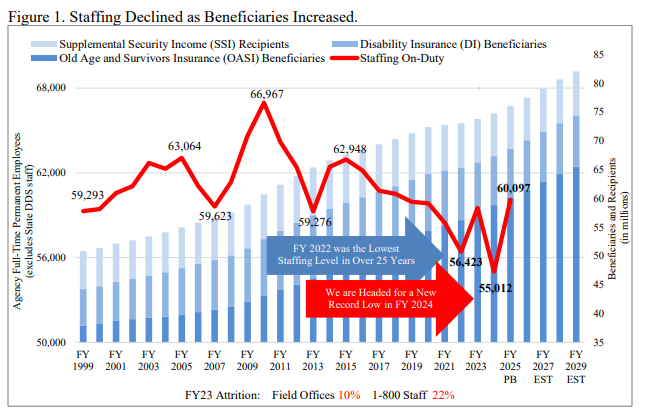Politics
SSA wants to reduce workforce by 7,000 through VERA/VSIP

Already facing a 50-year staffing low as the number of Social Security beneficiaries continuing to rise, the Social Security Administration is seeking to reduce its workforce.
SSA will offer employees voluntary separation incentives and early retirement options as part of a major reorganization.
“Through these massive reorganizations, offices that perform functions not mandated by statute may be prioritized for reduction-in-force actions that could include abolishment of organizations and positions, directed reassignments and reductions in staffing,” SSA stated in a Feb. 27 release. “The agency may reassign employees from non-mission critical positions to mission critical direct service positions (e.g., field offices, teleservice centers, processing centers). Reassignments may be involuntary and may require retraining for new workloads.”
SSA says its looking to shed about 7,000 workers. The latest data from last March says SSA had 56,645 employees, up slightly from 2023 and down from 66,967 in 2010.
Source: President Biden’s 2025 budget request.
SSA says employees who want to take the early retirement can do so between March 1 and Dec. 31 and must leave by the end of calendar year 2025.
“Employees not eligible now or who wish to retire later in the year under early out may do so, but may be subject to restructuring activities,” SSA said. “Employees who are not yet eligible for voluntary early retirement, but who would like to apply later in the calendar year should alert management of their intent to do so and work with their servicing benefits specialists to process their cases as their dates become due.”
Employees qualify for early retirement if:
- They have been in the government for at least 20 years of creditable service and be at least 50 years of age
- They have been in the government for at least 25 years of creditable service at any age (this must include 5 years of civilian service).
- They are serving under a non-time-limited appointment.
- They have been continuously on SSA’s rolls at least 30 days prior to Jan.17.
- They are not in receipt of an involuntary separation decision for misconduct or unsatisfactory performance.
At the same time, SSA is offering all employees, including those who retire early, voluntary separation incentive payments (VSIP) starting March 14. This option is not available for anyone who took part in the Deferred Resignation Program.
“Employees must opt in by March 14 and separate from the agency no later than April 19. Employees may be placed on administrative leave through April 19,” SSA stated. “Employees must complete the VSIP sign up as soon as possible, but no later than March 14 at Noon EST. Please let your manager know immediately if you sign up for VSIP. Completing the form does not guarantee VSIP.”
SSA is offering separation payments ranging from $15,000 to $25,000.
- Up to GS 8 $15,000
- GS 9–12 $20,000
- GS 13 and up $25,000
SSA says certain employees are not eligible for VSIP payments, including reemployed annuitants, anyone who has a disability such that the individual is or would be eligible for disability retirement or anyone who received or is slated to receive a recruitment or relocation incentive in the last 24 months.
The agency says if it can’t get down to about 50,000 employees through these tools, a reduction-in-force (RIF) is possible. It has asked the Office of Personnel Management for approval.
Five other offers since 2012
The last time SSA offered voluntary early retirements and VSIPs was in 2021. At that time about 175 employees, or slightly more than 2% of those eligible, accepted the offer.
SSA has offered early outs several times in recent years. The agency usually announces an early-out opportunity once a year. SSA offered early retirements in 2012, 2014, 2017 and 2019. In the past, anywhere from 3-to-4 % of those eligible took the early retirement offer.
These new efforts would wipe out any workforce gains made over the last four years. SSA had planned to hire almost 4,000 new employees in fiscal 2025 as outlined in former President Joe Biden’s 2025 budget request.
Former SSA Commissioner Martin O’Malley told House lawmakers last year that as a result of the staffing problems, customer service has worsened. There are longer wait times on phone lines and longer delays in receiving decisions on disability applications and appeals.
Right now, SSA employees “are understaffed, and they are overwhelmed,” O’Malley said. “Not surprisingly, when somebody’s been on hold for an hour, they come off that call hot. We right now have an attrition rate of about 24% in our teleservice centers.”
SSA eliminates 3 offices
The restructuring and rebalancing comes after years of trying to improve SSA’s workforce. In 2024, the Federal Employee Viewpoint Survey (FEVS) showed SSA’s employee engagement, satisfaction and agency leadership are all trending positively. The agency increased its engagement index score from 65% positive responses in 2023, to 68% positive results in 2024.
In addition to the workforce restructuring, SSA is reorganizing its offices.
“SSA has operated with a regional structure consisting of 10 offices, which is no longer sustainable. The agency will reduce the regional structure in all agency components down to four regions,” the agency stated. “The organizational structure at headquarters also is outdated and inefficient. SSA will now have seven deputy commissioner level organizations.”
The reorganization will “prioritize customer service by streamlining redundant layers of management, reducing non-mission critical work and potential reassignment of employees to customer service positions. Also supporting this priority is looking for efficiencies and other opportunities to reduce costs across all spending categories, including IT and contractor spending.”
Additionally last week, SSA said its closing down the Office of Analytics, Review and Oversight (OARO) and moving those functions into other offices. It’s also getting rid of the Office of Transformation and the Office of Civil Rights and Equal Opportunity, altogether, putting those employees on paid administrative leave.
The post SSA wants to reduce workforce by 7,000 through VERA/VSIP first appeared on Federal News Network.
Politics
President Trump Taps Dr. Ben Carson for New Role — A HUGE Win for America First Agenda

Dr. Ben Carson is the newest member of the Trump administration.
On Wednesday, former Secretary of the Department of Housing and Urban Development, Ben Carson, was sworn in as the national adviser for nutrition, health, and housing at the U.S. Department of Agriculture.
Agriculture Secretary Brooke Rollins shared that Carson’s role will be to oversee Trump’s new Big Beautiful Bill law, which aims to ensure Americans’ quality of life, from nutrition to stable housing.
After being sworn in, Carson shared, “Today, too many Americans are suffering from the effects of poor nutrition. Through common-sense policymaking, we have an opportunity to give our most vulnerable families the tools they need to flourish.”
WATCH:
BREAKING Dr. Ben Carson has been sworn in as the National Nutrition Advisor to Make America Healthy Again
THIS IS A HUGE WIN pic.twitter.com/Dr5AsSDkRM
— MAGA Voice (@MAGAVoice) September 24, 2025
Per USDA:
Today, U.S. Secretary of Agriculture Brooke L. Rollins announced that Dr. Benjamin S. Carson, Sr., M.D., was sworn in as the National Advisor for Nutrition, Health, and Housing at the U.S. Department of Agriculture (USDA).
“There is no one more qualified than Dr. Carson to advise on policies that improve Americans’ everyday quality of life, from nutrition to healthcare quality to ensuring families have access to safe and stable housing,” said Secretary Rollins.
“With six in ten Americans living with at least one chronic disease, and rural communities facing unique challenges with respect to adequate housing, Dr. Carson’s insight and experience is critical. Dr. Carson will be crucial to implementing the rural health investment provisions of the One Big Beautiful Bill and advise on America First polices related to nutrition, health, and housing.
“As the U.S. Secretary of Housing and Urban Development in the first Trump Administration, Dr. Carson worked to expand opportunity and strengthen communities, and we are honored to welcome him to the second Trump Administration to help lead our efforts here at USDA to Make America Healthy Again and ensure rural America continues to prosper.”
“Today, too many Americans are suffering from the effects of poor nutrition. Through common-sense policymaking, we have an opportunity to give our most vulnerable families the tools they need to flourish,” said Dr. Ben Carson. “I am honored to work with Secretary Rollins on these important initiatives to help fulfill President Trump’s vision for a healthier, stronger America.”
On Sunday, Dr. Carson was one of the many speakers at the memorial service of the late TPUSA founder Charlie Kirk.
During the memorial service, Carson highlighted that Kirk was shot at 12:24 p.m. and then continued to share the Bible verse John 12:24, which reads, “Verily, verily, I say unto you, Except a corn of wheat fall into the ground and die, it abideth alone: but if it die, it bringeth forth much fruit.”
WATCH:
Ben Carson reads John 12:24 at the Charlie Kirk’s funeral. Charlie was shot at 12:24.
It reads: “Very truly I tell you, unless a kernel of wheat falls to the ground and dies, it remains only a single seed. But if it dies, it produces many seeds”
God is moving and speaking. pic.twitter.com/0ZbVTAwwYl
— Danny Botta (@danny_botta) September 21, 2025
The post President Trump Taps Dr. Ben Carson for New Role — A HUGE Win for America First Agenda appeared first on The Gateway Pundit.
Politics
LEAKED MEMO: Deep State Prosecutors in the Eastern District of Virginia Claim There Isn’t Enough Evidence to Convict Comey Amid Reports of Imminent Indictment


On Wednesday evening, disgruntled officials in the Eastern District of Virginia leaked contents of a memo explaining why charges should not be brought against James Comey.
As reported earlier, former FBI Director James Comey is expected to be indicted in the Eastern District of Virginia in the next few days.
Comey will reportedly be charged for lying to Congress in a 2020 testimony about whether he authorized leaks to the media.
Officials in the Eastern District of Virginia are still fighting to stop Comey from being charged after Trump fired US Attorney Erik Siebert.
President Trump last week fired Erik Siebert as the US Attorney for the Eastern District of Virginia because he refused to bring charges against Letitia James, Comey, Schiff and others.
On Saturday evening, President Trump announced that he had appointed Lindsey Halligan – his personal attorney who defended him against the Mar-a-Lago raid – as US Attorney for the Eastern District of Virginia.
Now, with just days to go before the statute of limitations runs out to charge Comey for lying during a September 30, 2020 testimony, Lindsey Halligan is reportedly gearing up to indict Comey.
Prosecutors reportedly gave newly sworn-in Halligan a memo defending James Comey and explaining why charges should not brought against the fired FBI Director.
Per MSNBC’s Ken Dilanian:
Two sources familiar with the matter tell me prosecutors in the EDVA US attorney‘s office presented newly sworn US attorney Lindsey Halligan with a memo explaining why charges should not be brought against James Comey, because there isn’t enough evidence to establish probable cause a crime was committed, let alone enough to convince a jury to convict him.
Justice Department guidelines say a case should not be brought unless prosecutors believe it’s more likely than not that they can win a conviction beyond a reasonable doubt.
Two sources familiar with the matter tell me prosecutors in the EDVA US attorney‘s office presented newly sworn US attorney Lindsey Halligan with a memo explaining why charges should not be brought against James Comey, because there isn’t enough evidence to establish probable…
— Ken Dilanian (@DilanianMSNBC) September 24, 2025
The post LEAKED MEMO: Deep State Prosecutors in the Eastern District of Virginia Claim There Isn’t Enough Evidence to Convict Comey Amid Reports of Imminent Indictment appeared first on The Gateway Pundit.
Politics
Nearly 8 in 10 Voters Say the United States is in Political Crisis After the Assassination of Charlie Kirk

Nearly eight in ten voters believe that the United States is in a political crisis in the wake of the assassination of conservative icon Charlie Kirk.
According to a Quinnipiac University national poll of registered voters released on Wednesday, a massive 93 percent of Democrats, 84 percent of independents, and 60 percent of Republicans said the nation is in a political crisis.
“The Kirk assassination lays bare raw, bipartisan concerns about where the country is headed,” Quinnipiac University Polling Analyst Tim Malloy said of the poll results.
Quinnipiac reports:
Seventy-one percent of voters think politically motivated violence in the United States today is a very serious problem, 22 percent think it is a somewhat serious problem, 3 percent think it is a not so serious problem, and 1 percent think it is not a problem at all.
This is a jump from Quinnipiac University’s June 26 poll when 54 percent thought politically motivated violence in the United States today was a very serious problem, 37 percent thought it was a somewhat serious problem, 6 percent thought it was a not so serious problem, and 2 percent thought it was not a problem at all.
Nearly 6 in 10 voters (58 percent) think it will not be possible to lower the temperature on political rhetoric and speech in the United States, while 34 percent think it will be possible.
Over half, 54 percent, of voters believe the US will see increased political violence over the next few years. Another 27 percent said they think it will stay “about the same,” while just 14 percent believe it will ease.
A 53 percent majority also said they are “pessimistic about freedom of speech being protected in the United States.”
Surprisingly, a 53 percent majority also believes the current system of democracy is not working.
“From a perceived assault on freedom of speech to the fragility of the democracy, a shudder of concern and pessimism rattles a broad swath of the electorate. Nearly 80 percent of registered voters feel they are witnessing a political crisis, seven in ten say political violence is a very serious problem, and a majority say this discord won’t go away anytime soon,” Malloy added.
The vast majority, 82 percent, said the way that people discuss politics is contributing to the violence.
“When asked if political discourse is contributing to violence, a rare meeting of the minds…Republicans, Democrats, and independents in equal numbers say yes, it is,” Malloy said.
The survey was conducted from September 18 to 21 among 1,276 registered voters with a margin of error of +/- 3.3 percentage points.
The post Nearly 8 in 10 Voters Say the United States is in Political Crisis After the Assassination of Charlie Kirk appeared first on The Gateway Pundit.
-

 Entertainment6 months ago
Entertainment6 months agoNew Kid and Family Movies in 2025: Calendar of Release Dates (Updating)
-

 Entertainment3 months ago
Entertainment3 months agoBrooklyn Mirage Has Been Quietly Co-Managed by Hedge Fund Manager Axar Capital Amid Reopening Drama
-
Tech6 months ago
The best sexting apps in 2025
-

 Entertainment5 months ago
Entertainment5 months agoKid and Family TV Shows in 2025: New Series & Season Premiere Dates (Updating)
-

 Tech7 months ago
Tech7 months agoEvery potential TikTok buyer we know about
-
Tech7 months ago
iOS 18.4 developer beta released — heres what you can expect
-

 Tech7 months ago
Tech7 months agoAre You an RSSMasher?
-

 Politics7 months ago
Politics7 months agoDOGE-ing toward the best Department of Defense ever




